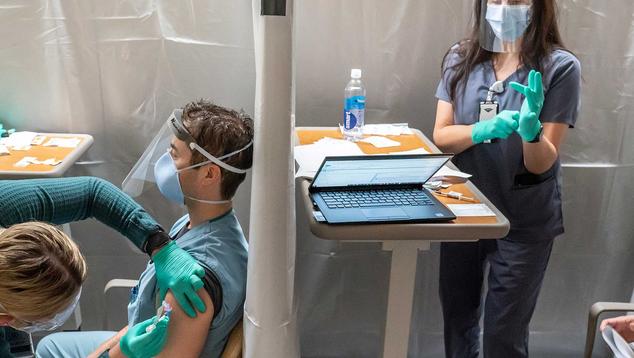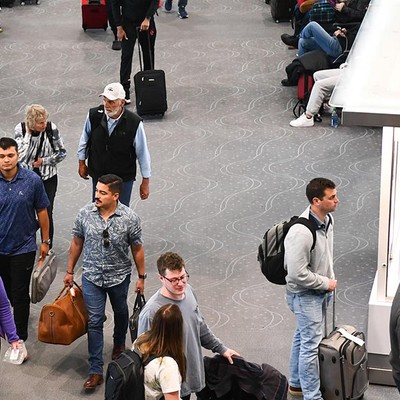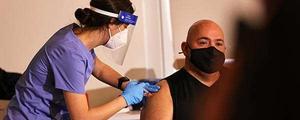Story Highlights
- 49% of healthcare workers/first responders would get COVID-19 vaccine
- Those who got flu vaccine more likely to get COVID-19 vaccine
Amid nationwide efforts to vaccinate the population against COVID-19, 49% of healthcare workers and first responders say that they would agree to receive the vaccine, while 34% say they would not, and 18% said they did not know whether or not they would agree to get the vaccine. According to new findings from the Franklin Templeton-Gallup Economics of Recovery Study, these front-line workers are about as likely as workers in other sectors to say they would agree to be vaccinated with a COVID-19 vaccine that was free, available, FDA approved and 90% effective.
For the analysis, Gallup identified those who work in professions that the National Academies of Engineering, Science and Medicine defines as "Tier 1A workers" in terms of desired vaccine priority. The NAESM priority tiers are intended to take into account the frequency and risk of exposure to COVID-19. They also prioritize workers in sectors that are critical to meeting health, safety and critical economic functioning in the U.S. Modest vaccine acceptance rates among those whose occupations place them in the highest priority group are particularly concerning given the increased risk of workplace exposure to COVID-19 among those in healthcare and other essential sectors.
| Tier 1a | Tier 2 | Tier 3 | ||||||||||||||||||||||||||||||||||||||||||||||||||||||||||||||||||||||||||||||||||||||||||||||||||
|---|---|---|---|---|---|---|---|---|---|---|---|---|---|---|---|---|---|---|---|---|---|---|---|---|---|---|---|---|---|---|---|---|---|---|---|---|---|---|---|---|---|---|---|---|---|---|---|---|---|---|---|---|---|---|---|---|---|---|---|---|---|---|---|---|---|---|---|---|---|---|---|---|---|---|---|---|---|---|---|---|---|---|---|---|---|---|---|---|---|---|---|---|---|---|---|---|---|---|---|---|
| % | % | % | ||||||||||||||||||||||||||||||||||||||||||||||||||||||||||||||||||||||||||||||||||||||||||||||||||
| Yes | 49 | 47 | 53 | |||||||||||||||||||||||||||||||||||||||||||||||||||||||||||||||||||||||||||||||||||||||||||||||||
| No | 34 | 32 | 27 | |||||||||||||||||||||||||||||||||||||||||||||||||||||||||||||||||||||||||||||||||||||||||||||||||
| Don't know | 18 | 21 | 20 | |||||||||||||||||||||||||||||||||||||||||||||||||||||||||||||||||||||||||||||||||||||||||||||||||
| Did you get the influenza (common flu) vaccine last year? | ||||||||||||||||||||||||||||||||||||||||||||||||||||||||||||||||||||||||||||||||||||||||||||||||||||
| Yes | 65 | 45 | 48 | |||||||||||||||||||||||||||||||||||||||||||||||||||||||||||||||||||||||||||||||||||||||||||||||||
| No | 35 | 55 | 52 | |||||||||||||||||||||||||||||||||||||||||||||||||||||||||||||||||||||||||||||||||||||||||||||||||
| Note: Tier 1a: Healthcare workers and protective services; Tier 2: Educational services, retail services, production occupations; Tier 3: Workers in other industries | ||||||||||||||||||||||||||||||||||||||||||||||||||||||||||||||||||||||||||||||||||||||||||||||||||||
| FRANKLIN TEMPLETON-GALLUP ECONOMICS OF RECOVERY STUDY, Dec. 1-6, 2020 | ||||||||||||||||||||||||||||||||||||||||||||||||||||||||||||||||||||||||||||||||||||||||||||||||||||
Important in these findings is that about 1 in 5 workers says that they don't know whether they would get the vaccine if it were available to them. In a separate December survey, Gallup found that 65% of all Americans would agree to receive a COVID-19 vaccine. That survey did not provide an option for respondents to indicate that they were unsure about whether they would accept a vaccine, which could account for most of the difference in the estimates. The findings in this research indicate that there is some hesitancy to get the vaccine among workers in all sectors.
The modest COVID-19 vaccine acceptance rates among healthcare workers and first responders are notable given that a much larger proportion of this group reported that they received a flu vaccine in 2019. Previous work has found that people who received a flu vaccine in the recent past were more likely to say that they would agree to a COVID-19 vaccination in the future. The relationship between past vaccination against the flu and willingness to be vaccinated against COVID-19 is seen across occupations in the current study. However, while across most respondents and occupation groups, a higher percentage of people say they will get the COVID vaccine than have gotten the flu vaccine, for healthcare workers, it is the reverse. Even among those who received a flu vaccine in 2019, front-line workers are the least likely to indicate a willingness to get a COVID-19 vaccine.

Horizontal bar graph. The percentages of U.S. adults who agree to receive the COVID-19 vaccine, by NAESM framework tie. 63% of those in tier 1a, 67% in Tier 2 and 74% of those in Tier 3 agree to receive the vaccine.
Healthcare workers do not appear to be more or less afraid of COVID. Levels of worry about becoming infected from COVID, suffering severe health effects due to COVID or infecting others are similar across occupation groups. Rather, the gap between flu vaccine coverage and COVID vaccination intentions among healthcare workers might result from the fact that flu vaccination is mandatory for many healthcare workers, but not those in other fields.

Horizontal bar graph. The percentages of U.S. Adults who are worried about COVID-19 outcomes for themselves or others by NAESM framework tie. In Tier 1a, 24% are worried they will catch COVID, 30% worry they will experience serious health effects if they catch COVID and 38% are worried they would infect others around them. In Tier 2, 26% are worried they will catch COVID, 29% worry they will experience serious health effects if they catch COVID and 42% are worried they would infect others around them. In Tier 3, 25% are worried they will catch COVID, 30% worry they will experience serious health effects if they catch COVID and 39% are worried they would infect others around them.
The limited COVID-19 vaccine acceptance rates among all occupation groups show little movement since November 2020. This is consistent with findings that COVID-19 vaccine acceptance is stable across the U.S.

Horizontal bar graph. The percentages of U.S. Adults who willing to received a COVID-19 vaccine on December 20, compared with those willing to do so on November 20, by NAESM framework tie. In Tier 1a, 49% were willing December 20, compared with 45% on November 20. In Tier 2, 47% were willing December 20, compared with 42% on November 20. In Tier 3, 53% were willing December 20, compared with 50% on November 20.
Implications
As the number of COVID-19 infections and deaths in the U.S. continue to rise, it is critical to vaccinate workers who are at the greatest risk of infection and whose occupations are essential for health, safety and economic functioning. Vaccine reluctance among these groups may pose a barrier to slowing the rates of community spread of COVID-19. Indeed, a recent Washington State Health Department report suggests that healthcare workers account for more COVID infections than workers in any other sector.
As public health officials and other groups consider ways to improve COVID-19 vaccine acceptance, multiple strategies may be needed to address the specific concerns of those who are reluctant to be vaccinated. Prior research has found that vaccine acceptance can be boosted through various strategies, such as a recommendation from care providers with whom people have existing relationships, local availability, and recommendations from groups such as the Centers for Disease Controls (CDC) and other public health departments. Additionally, this work found that information about safety and efficacy could boost willingness to receive a COVID-19 vaccination. Emphasizing these factors may be particularly beneficial for improving acceptance among those who have been previously vaccinated against other illnesses (such as flu). Finally, highlighting the possibility of transmitting the virus to others may provide an opportunity for increasing acceptance among front-line workers.




